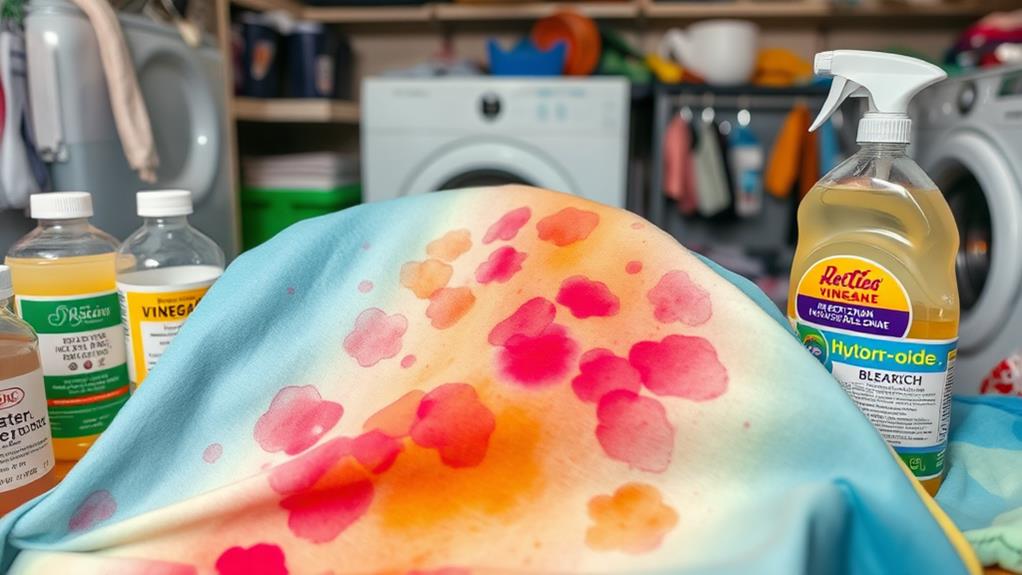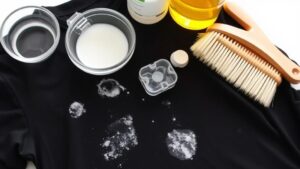You can address bleach stains, but complete removal can be tricky. Start by rinsing the area with cold water immediately to dilute the bleach. Home remedies like a baking soda paste or a vinegar solution can help neutralize the stain. For tougher spots, consider using hydrogen peroxide or a commercial stain remover, but always patch-test first. If the damage is severe, you might want to explore creative options like tie-dying or embellishing the fabric. There are several approaches to salvage your fabrics, and you might find the perfect solution by exploring them further.
Understanding Bleach Stains
When you use bleach on fabrics, you might notice that it can create unsightly stains. These bleach stains occur due to a chemical reaction where bleach oxidizes the color molecules in the fabric. This process leads to lighter spots or even total color loss. The severity of the stains largely depends on the concentration of bleach used; stronger solutions can inflict more extensive damage on your textiles.
Understanding the importance of expense tracking tools in managing costs can also help in reducing fabric damage by allowing you to budget for proper cleaning supplies. Natural fibers, like cotton and linen, are particularly susceptible to bleach damage. If you've ever noticed that your favorite cotton shirt has developed a spot, it's likely due to this chemical reaction. While synthetic materials can also experience discoloration, they may yellow instead of showing bleach stains.
Understanding the type of fabric and the duration of bleach exposure is essential for evaluating damage. Lighter fabrics might be easier to restore than darker ones. Additionally, patterns or prints can sometimes help mask bleach stains, making them less noticeable.
Immediate Actions to Take
When you notice a bleach stain, act fast to minimize the damage. Start by rinsing the area with cold water to dilute the bleach and prevent it from setting in.
This quick response not only helps in minimizing the stain but also keeps your financial responsibilities in check, as you can set up custom notifications based on payment schedules for other important tasks.
Then, use a clean white cloth to blot the stain and absorb any excess bleach before it spreads.
Quick Rinsing Techniques
Bleach stains can be intimidating, but quick action is your best defense. Start by immediately rinsing the affected area with cold water. This is one of the most effective quick rinsing techniques, as it dilutes and removes the bleach before it can cause further damage. Aim to do this within minutes of the stain occurrence.
When rinsing, push the water from the back of the fabric towards the front. This helps flush out the bleach and prevents it from spreading further.
After rinsing, use a clean white cloth to blot the stain gently. Avoid rubbing, as this can damage the fabric and spread the bleach.
For additional cleaning, you can apply a mild dish soap solution to the stained area. Allow it to sit for a moment before rinsing again with cold water.
Neutralizing Bleach Effectively
Swift action is essential for neutralizing bleach stains effectively. The first step you should take is to rinse the stained area with cold water immediately. This helps dilute the bleach and minimizes damage. Be sure to flush the area from the back, pushing out the bleach as you go.
After rinsing, you can enhance your efforts by using a paste made from baking soda and water. Apply this paste to the stain for about 10 minutes; it can help neutralize bleach and reduce further discoloration.
If you want to try another method, mix lemon juice with water and gently apply it to the stained area using a clean white cloth or a soft toothbrush. This can help neutralize the bleach stains while also working to whiten the fabric.
For more stubborn stains, consider using sodium thiosulfate, which effectively counteracts the chemical reaction causing discoloration. Remember, acting swiftly—within minutes of bleach exposure—is crucial to successfully neutralize the bleach and prevent permanent staining.
Methods for Removing Stains
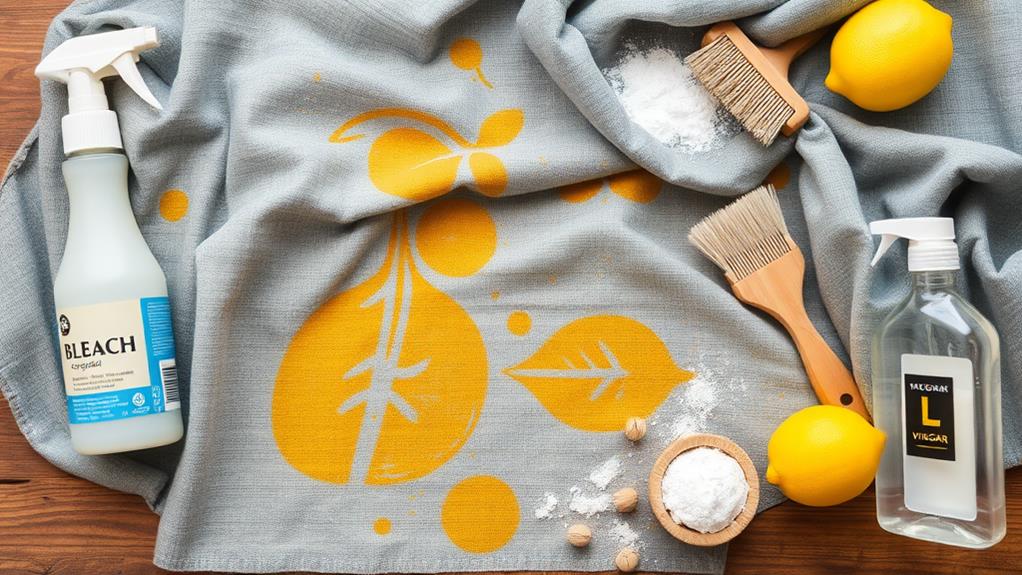
Removing bleach stains requires quick action and the right methods. If you act fast, you can minimize damage and discoloration. Here are some effective methods for removing bleach stains:
1. Rinse with Cold Water: Immediately rinse the stained area with cold water to dilute the bleach and stop further damage.
Utilizing tools like expense management apps can help streamline your household finances, allowing you to allocate funds for any necessary replacements or professional cleaning services, enhancing your overall financial organization.
2. White Vinegar Solution: Mix equal parts of white vinegar and water. Apply it gently to the stain. This can help neutralize the bleach, making it less visible.
3. Hydrogen Peroxide Treatment: For tougher stains, dab hydrogen peroxide on the area. It can lighten the stain without damaging the fabric too much.
4. Color Remover: If you're dealing with particularly stubborn stains, consider a color remover. Just remember to do a patch test first to verify it doesn't cause additional damage.
For those persistent or delicate fabric stains, don't hesitate to consult professionals. They've specialized techniques and products that can effectively tackle removing bleach stains without further harm to your fabrics.
Home Remedies That Work
Finding effective home remedies for bleach stains can feel like a challenge, but several options can help restore your fabric without causing further damage.
One popular method involves mixing equal parts of white vinegar and water. This solution gently treats the stain and helps preserve the integrity of your fabric. Additionally, opting for eco-friendly cleaning methods aligns with sustainable packaging solutions that prioritize minimal environmental impact.
Another option is to create a paste from baking soda and water. Apply it to the stain, let it sit for about 10 minutes, and then rinse it off to neutralize the bleach.
You can also try a salt and water paste, leveraging salt's natural cleaning properties to lift discoloration. For those sunny days, a mixture of lemon juice and water can work wonders, especially when exposed to sunlight, as citric acid acts as a natural bleaching agent.
Before trying any of these home remedies, always perform a spot test on an inconspicuous area to confirm it won't damage the fabric.
While these natural cleaning methods can be effective, remember that more severe stains might require professional cleaning services for the best results.
Professional Cleaning Services

Home remedies can be effective for minor bleach stains, but when faced with stubborn discoloration or valuable fabrics, professional cleaning services offer a reliable solution.
These experts possess specialized knowledge and advanced equipment, making them adept at tackling tough bleach stains from carpet and other materials.
Additionally, utilizing bill tracking tools can help you manage the costs associated with professional cleaning services, ensuring you stay on top of your finances.
Here are a few reasons to evaluate hiring professionals:
- Expert Techniques: Professionals use commercial-grade stain removers that outperform typical household products, increasing the chances of success.
- Tailored Solutions: They often conduct spot tests to customize the cleaning process for your specific fabric and stain type, reducing the risk of further damage.
- Time-Saving: Hiring a professional can save you time and frustration, especially when dealing with high-value or sentimental items that require careful handling.
- Cost-Effective: Engaging a service can be more economical in the long run, as it helps avoid the expense of replacing damaged items.
Preventing Future Stains
To prevent future bleach stains, always check fabric care labels before using bleach to verify it's safe for the material.
Additionally, consider implementing clear payment terms to help you better manage your laundry expenses.
Make sure to dilute bleach properly and mix it well in your washing machine to avoid concentrated spots.
Taking these simple steps can save your clothes from unwanted discoloration.
Fabric Care Labels
Understanding fabric care labels is essential for preventing future bleach stains on your clothes. These labels provide vital information about how to wash and treat your garments properly. They outline which cleaning agents are safe to use and if the fabric is bleach-safe.
Here are four key things to look for on fabric care labels:
- Bleach Symbols: Look for the triangle symbol, which indicates whether bleaching is allowed. If it's crossed out, avoid bleach entirely.
- Bleach Type: Some labels specify the type of bleach you can use, such as chlorine or oxygen bleach. Using the wrong type can result in irreversible stains.
- Washing Instructions: Pay attention to the recommended washing temperatures. Higher temperatures can exacerbate the effects of bleach on certain fabrics.
- Drying Guidelines: Follow drying instructions, as high heat can set any existing stains, including those from bleach.
Proper Bleach Usage
Knowing how to use bleach properly is vital to preventing future stains on your fabrics. First, always check fabric care labels to see which bleach products are compatible with your materials. This step is essential to avoid accidental damage. Before applying household bleach, conduct a spot test on a hidden area to verify the fabric won't react negatively.
When you're ready to wash, follow this step-by-step guide: dilute the bleach in water to avoid concentrated spots that can lead to bleach stains. Make certain it's evenly distributed in your washing machine.
Additionally, store bleach securely and away from colored items to minimize the risk of spills that could stain your laundry.
Always use bleach in well-ventilated areas and wear rubber gloves to protect your skin during application.
Why Bleach Causes Yellowing
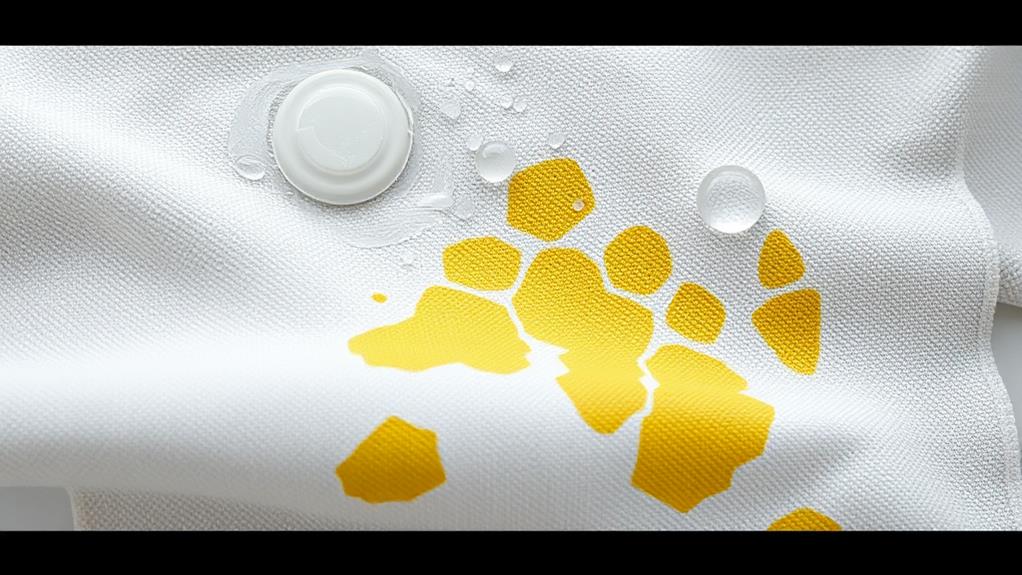
Why Bleach Causes Yellowing
Why does bleach lead to that frustrating yellowing of your favorite fabrics? When you use bleach, it breaks down the dyes in the fabric, resulting in the formation of yellow compounds. This is especially problematic for natural fibers like cotton and linen, which are more susceptible to yellowing.
Additionally, understanding the importance of expense categorization can help you better manage your cleaning supplies and avoid overusing harsh chemicals like bleach. Synthetic fabrics can also yellow, but the effect is often less pronounced due to their different composition. However, the breakdown of rubberized technology in synthetic materials can introduce additional chemicals that worsen the yellowing effect.
Here are a few factors that contribute to the yellowing caused by bleach:
- Composition of Fabrics: Natural fibers react more severely to bleach than synthetic ones.
- pH Balance: An unbalanced pH in your washing water can intensify yellowing.
- Water Impurities: Minerals and impurities in water can interact with bleach, leading to discoloration.
- Exposure Time: Prolonged exposure to bleach increases the risk of yellowing.
Understanding these factors can help you make informed decisions about using bleach on your fabrics and potentially avoid that unwanted yellowing.
Salvaging Damaged Fabrics
When bleach leaves its mark on your fabrics, don't throw them away just yet. You can get creative with recoloring techniques like tie-dying or use embellishments to breathe new life into your garments.
Additionally, consider incorporating sustainable fashion practices by choosing eco-friendly materials for upcycling projects, which aligns with ethical fashion choices.
Upcycling stained items not only saves money but also adds a personal touch to your wardrobe.
Creative Recoloring Techniques
Bleach stains can turn a beloved garment into a disappointment, but with creative recoloring techniques, you can breathe new life into damaged fabrics.
While you can't restore the original color, you can effectively repurpose the item and make it unique. Here are some fun methods to contemplate:
- Tie-Dying: Embrace the vibrant world of tie-dying! This technique allows you to create intentional color variations that mask bleach stains, turning your fabric into a one-of-a-kind masterpiece.
- Fabric Markers: Grab some fabric markers and release your artistic side. You can draw designs or patterns over the affected area, cleverly hiding bleach stains while enhancing the overall look of the garment.
- Embroidery: If you enjoy sewing, embroidery is a fantastic option. Stitching over the bleach stains adds texture and decoration, giving your fabric a fresh and stylish touch.
- Cutting and Crafting: For a practical approach, contemplate cutting the stained fabric into smaller items like rags or pouches. This not only reduces waste but also gives a new purpose to materials that would otherwise be discarded.
With these creative techniques, you can transform disappointment into inspiration!
Upcycling Stained Fabrics
Stained fabrics don't have to end up in the trash; they can be transformed into something new and useful. Upcycling is a fantastic way to breathe new life into items that have suffered from bleach stains. You can create tote bags, pillow covers, or decorative pieces, extending their life beyond their original use.
Consider tie-dying your stained fabric to mask those bleach stains. This technique introduces fresh colors and patterns, giving your fabric an artistic makeover. Alternatively, use fabric markers or paint to cover up those unsightly spots. You can add personal designs that enhance the overall look while making the stains less noticeable.
For an even more creative approach, try embroidery. Stitching over bleach spots not only conceals the damage but also adds texture and visual interest to your fabric.
If you prefer a more straightforward solution, cut the stained fabric into smaller items like rags or pouches. This not only reduces waste but also provides functional uses for materials that would otherwise be discarded.
Embrace upcycling and turn those damaged fabrics into something beautiful and practical!
Repairing With Embellishments
Many creative options exist for repairing fabrics that have been marred by bleach stains. Instead of tossing out your favorite piece, why not try embellishing it?
Here are four fun ideas to get you started:
- Fabric Markers or Paint: Use these to cover up bleach stains, allowing your creativity to shine through. You can create unique designs that make the garment one-of-a-kind.
- Decorative Patches: Adding embroidered or decorative patches can effectively conceal those pesky bleach spots while giving your clothing a fashionable upgrade.
- Tie-Dye Technique: Transform the entire fabric by tie-dyeing over the bleach stains. This technique can turn a mistake into a vibrant, intentional design that's sure to catch attention.
- Upcycle Into Smaller Items: Consider cutting up the stained fabric to create pouches or cleaning rags. This not only reduces waste but also provides functional uses for the material.
Assessing the Damage
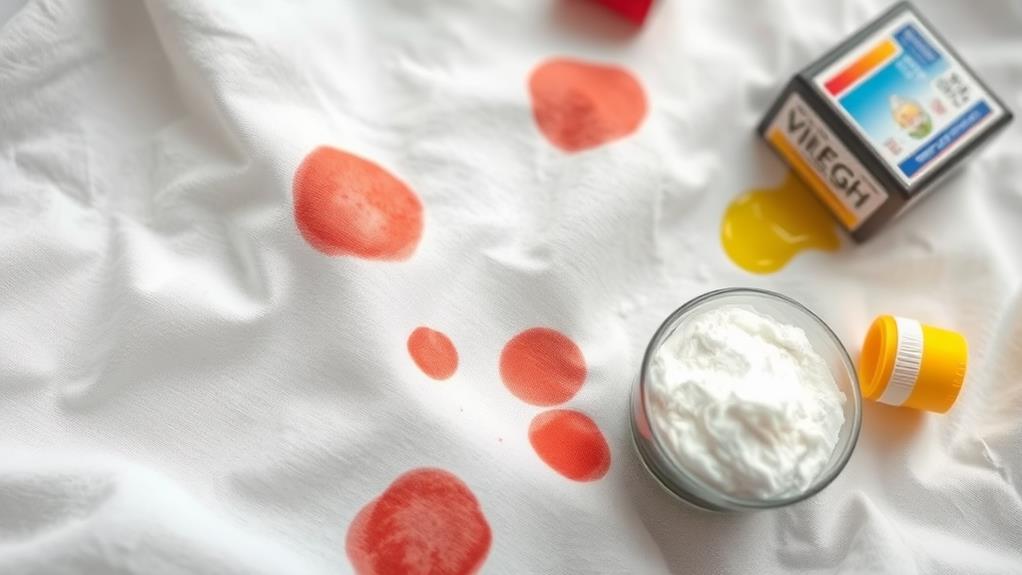
When it comes to evaluating the damage from bleach stains, you'll need to take into account several factors.
First, assess the concentration of bleach used; higher concentrations typically lead to more severe discoloration of your fabric.
Next, consider the duration of exposure—longer contact with bleach can intensify the damage, making it more challenging to treat.
Different fabric types respond differently to bleach.
Natural fibers like cotton and linen are particularly susceptible to damage, while synthetic materials may withstand bleach better.
Check if the color loss from the bleach stains is localized or widespread, as this can greatly influence your treatment options.
Effective Cleaning Techniques
After evaluating the damage from bleach stains, it's time to take action with effective cleaning techniques. Immediate action is vital, so start by rinsing the area with cold water to prevent further discoloration.
Here are four effective methods for cleaning bleach stains from your white fabrics:
- Mild Dish Soap: Mix a small amount of mild dish soap with warm water, and gently treat the bleach stain. This solution helps break down the residue without harming the fabric.
- Baking Soda Paste: Create a paste using baking soda and water. Apply it gently to the stain and let it sit for about 10 minutes. This can help neutralize the bleach and lift the stain.
- White Vinegar Solution: Mix white vinegar with water for a gentle cleaning alternative. Be careful not to rub the fabric, as this could cause further damage.
- Commercial Stain Removers: For stubborn bleach stains, consider using commercial stain removers specifically designed for this purpose. Always conduct a patch test before applying it to the entire stain.
Conclusion
So, you've turned your favorite shirt into a modern art masterpiece with those delightful bleach stains—congratulations! Whether you're wielding home remedies like a DIY wizard or calling in the pros, remember: it's all about embracing the chaos. You might end up with a patched-up masterpiece or a stylishly distressed look. Just don't blame the laundry fairy when things go awry! After all, every stain tells a story, even if that story is about your questionable laundry choices.

